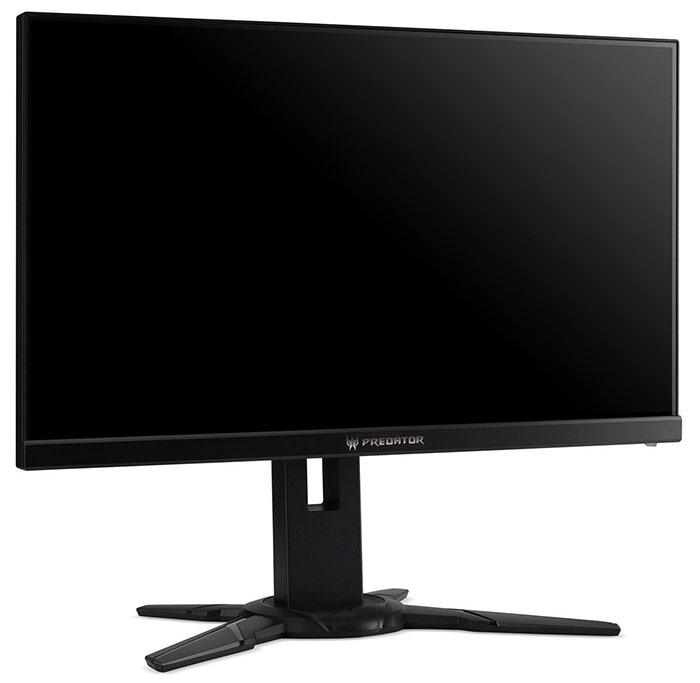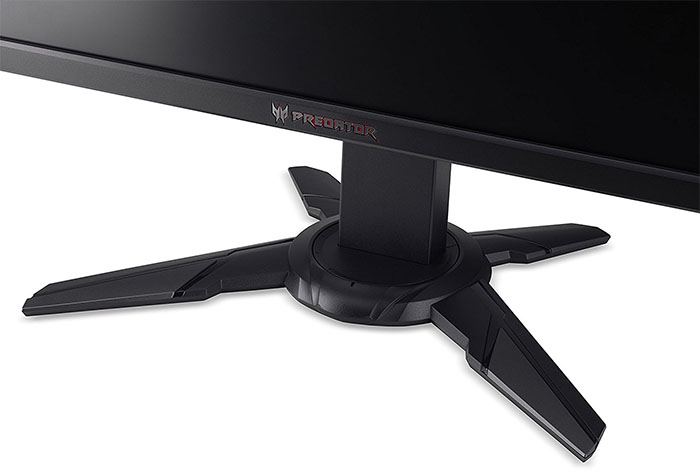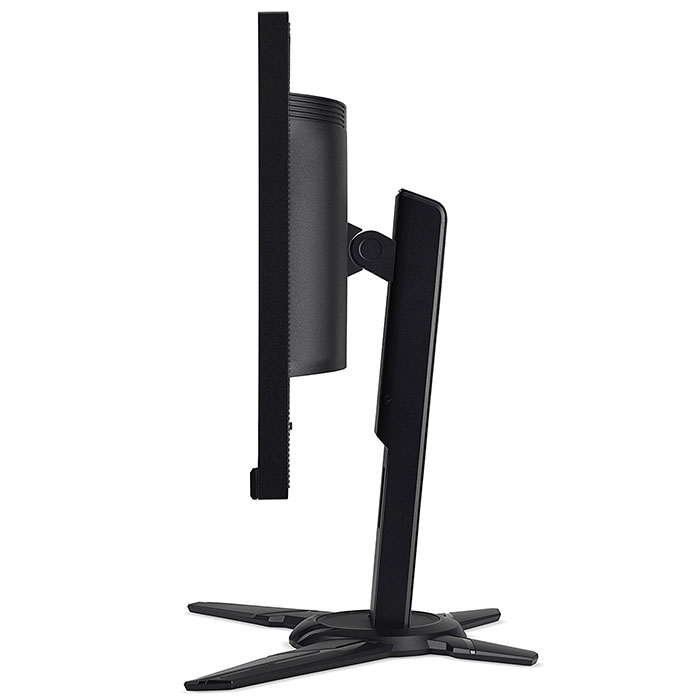Early Verdict
For gamers seeking the highest possible framerates, there is nothing faster than the Acer Predator XB252Q and its cousin from Asus. Despite a relatively low pixel density and merely average contrast, it offers a play experience that is second to none. With the complete absence of motion blur, tearing, and stutter, you’ll find yourself drawn into the game world in an almost visceral way. It may seem expensive for an FHD screen but we urge you to try before you buy. You might find yourself hooked.
Pros
- +
240Hz
- +
ULMB at 144Hz
- +
Light output
- +
G-Sync
- +
Build quality
- +
Styling
Cons
- -
Contrast
- -
Out-of-box color accuracy
- -
TN panel
Why you can trust Tom's Hardware
Features & Specifications
In the battle for gaming monitor supremacy, there’s Acer and Asus, and then there’s everyone else. Those two companies can always be counted on to push the envelope in display performance, and thanks to the Predator and Republic of Gamers lines, we have a large field of very fast screens that promise smooth action with the latest features, like G-Sync, ULMB, and high refresh rates.

Today, we’re checking out Acer’s answer to the Asus ROG PG258Q. The Predator XB252Q is similar to that excellent screen in nearly every way. They both share the same 25” FHD/TN panel with a native refresh rate of 240Hz, ULMB up to 144Hz, and G-Sync courtesy of Nvidia’s latest module, which adds an HDMI 1.4 input to the mix. Understated styling and a nearly zero-bezel design add up to a performance-oriented display that can anchor the highest of the high-end in gaming PCs. Let’s take a look.
Specifications
The spec sheets for both monitors are identical, so for most users, the decision will come down to brand loyalty and price. At this writing, the XB252Q undercuts Asus by around $70. It also offers subtler styling, which may appeal to some. Asus had incorporated a neat spaceship aesthetic into its latest ROG products with lighting that comes from the base. Acer sticks with a more industrial-looking panel and a base that suggests its intent without being too obvious.
An FHD-resolution TN panel may look like a lack of progress to some readers, but this is a performance-first product. Even with the stoutest video card, you’ll be hard-pressed to top 200 FPS with a QHD/IPS panel. And ultimately, motion resolution impacts picture quality more than outright pixel density. To that end, Acer has upped the ante with a super bright part that exceeds 400 nits and can run at 240Hz without overclock. ULMB is available at up to 144Hz, which makes the feature truly usable, and a viable alternative to G-Sync for reducing motion blur and other artifacts. Of course, G-Sync is there too, from 24-240Hz, which should ensure perfect motion no matter how intense the action becomes.
Packaging, Physical Layout & Accessories
Every side of the XB252Q’s oversized carton lays its intent out plainly. The feature list is printed clearly so you know just what you’re paying for. The contents are well protected and only require attachment of the upright, which snaps in place. The power supply is internal so an IEC cord is included. Video signals are carried by the provided HDMI and DisplayPort cables. If you find yourself in need of the USB ports, a v3.0 cable is in the box. Documentation is available from Acer’s website.
Product 360





Acer has gone for a simple style with the XB252Q that almost qualifies it as a sleeper product. The panel’s chassis looks like any other monitor with a bulge across the back and only a small Predator logo on the front. The bezel is quite thin at only 7mm across the top and sides and 21mm at the bottom. Like other “zero-frame” displays, there is a visible border around the image, but this is the smallest one we’ve seen yet. The anti-glare layer is 3H-hardness and fits tightly for a sharp and grain-free image. Our sample had no visible bleed or glow and rendered excellent uniformity.
The base shows a little style with its angular form and shiny trim. You’ll get to play the “find the wrap” game when unpacking, as all the glossy bits are protected by film. It looks minimal but underneath the hard plastic is a stout metal core. The monitor is very stable and shows no play or wobble in its movements. Adjustments include 4.8” of height, 45° swivel in each direction, 25° total tilt, and a portrait mode.
Controls are a mix of buttons and a firm-clicking joystick. They can be found around back but rather than going up the side, they are arrayed horizontally across the bottom. Small icons appear on the screen to tell you their functions. The menu system is excellent and will be familiar to users of the latest Acer monitors.
A large component bulge makes the XB252Q one of the thicker panels we’ve seen of late. At nearly 3", it won’t win any slimness awards. There is ample grill work to keep things cool and to allow the rear-firing speakers room to breathe. At 2W apiece, they won’t fill your room with sound, but they are adequate when there is no other alternative. If you wish to connect peripherals, two of the USB 3.0 ports are on the left side. Monitor arm users will find a 100mm VESA mount when the upright is removed.
The input panel is typical of the latest G-Sync monitors. You get one each of HDMI 1.4 and DisplayPort 1.2. Headphones can be plugged into the 3.5mm analog output. Two more downstream and a single upstream USB port are also found here.
MORE: Best Gaming Monitors
MORE: Best Professional Monitors
MORE: How We Test Monitors
MORE: How To Choose A Monitor
MORE: All Monitor Content

Christian Eberle is a Contributing Editor for Tom's Hardware US. He's a veteran reviewer of A/V equipment, specializing in monitors. Christian began his obsession with tech when he built his first PC in 1991, a 286 running DOS 3.0 at a blazing 12MHz. In 2006, he undertook training from the Imaging Science Foundation in video calibration and testing and thus started a passion for precise imaging that persists to this day. He is also a professional musician with a degree from the New England Conservatory as a classical bassoonist which he used to good effect as a performer with the West Point Army Band from 1987 to 2013. He enjoys watching movies and listening to high-end audio in his custom-built home theater and can be seen riding trails near his home on a race-ready ICE VTX recumbent trike. Christian enjoys the endless summer in Florida where he lives with his wife and Chihuahua and plays with orchestras around the state.
-
Lucky_SLS These 240Hz r for the Hardcore Henry of e-sports gamers,Reply
Bring out the HDR and FreeSync 2 beauties !!! -
dstarr3 The last time I had a TN panel was 15 years ago. I should give them another shot, they probably look a lot better today than they did the last time I had one.Reply -
AgentLozen I'm happy to see that engineers keep pushing the limits of panel technologies. It's a shame that this monitor couldn't have ran at a higher resolution or used a better display technology. Subjectively, can you see the difference between 144Hz and 240Hz?Reply
DSTARR3 said:The last time I had a TN panel was 15 years ago. I should give them another shot, they probably look a lot better today than they did the last time I had one.
I'm using a Dell TN at home. After a little calibration, I think it looks great. Sometimes I notice the shoddy viewing angles and I sometimes wonder if it would look a little nicer with 8-bit color, but I'm satisfied otherwise. If you're in the market for a gaming monitor and you don't have bionic eyes that are sensitive to minor color inaccuracy, I'm sure this monitor would be great for you. -
joz Maybe I'm showing my age...Reply
But when did Acer become a premium product supplier? They used to sit right above "EMachines" when it came to jokes (and spec sheets) about their products performance and quality.
That being said, I've been perfectly happy with my XB27. -
dstarr3 Reply20172847 said:I'm happy to see that engineers keep pushing the limits of panel technologies. It's a shame that this monitor couldn't have ran at a higher resolution or used a better display technology. Subjectively, can you see the difference between 144Hz and 240Hz?
DSTARR3 said:The last time I had a TN panel was 15 years ago. I should give them another shot, they probably look a lot better today than they did the last time I had one.
I'm using a Dell TN at home. After a little calibration, I think it looks great. Sometimes I notice the shoddy viewing angles and I sometimes wonder if it would look a little nicer with 8-bit color, but I'm satisfied otherwise. If you're in the market for a gaming monitor and you don't have bionic eyes that are sensitive to minor color inaccuracy, I'm sure this monitor would be great for you.
I actually do have "bionic eyes," lol. I do a lot of photo editing that relies on color-accurate, calibrated displays, and I can pretty reliably detect inaccuracies, which is why I ditched TN panels 15 years ago. But that being said, I don't really need critical accuracy when playing games. I think I'd be alright with a super-high refresh rate at the expense of super-accurate color in games. So long as it looks, like, not obviously way off, I'm sure I'd be fine with it. The viewing angles might be problematic, though. -
ubercake How can Acer use the same panel as Asus and provide a monitor with the same specs, but in reality so much lower contrast? $70 difference.Reply -
AgentLozen ReplyDSTARR3 said:I think I'd be alright with a super-high refresh rate at the expense of super-accurate color in games.
That's what I'm trying to describe. There's never been a time when I was like, "Does Mercy have brown hair or blonde hair?" The picture is pretty good especially after a little calibration. I'm speaking from the experience of my Dell TN.
-
dstarr3 Reply20173399 said:How can Acer use the same panel as Asus and provide a monitor with the same specs, but in reality so much lower contrast? $70 difference.
If I had to guess, binning. The panels roll off the line, some are better than others, Asus pays the premium for the best ones, Acer takes the rest.